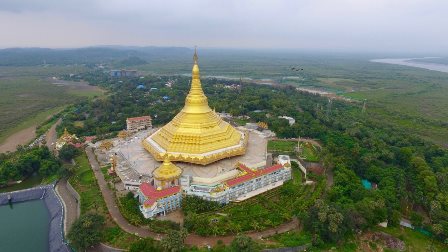"I have a great dream that a time will come when these two great ancient countries - China and India -will unite together on the platform of Vipassana to serve humanity, " the Principal Teacher of Vipassana Sayagyi U Goenka told a large group of Chinese Vipassana students from mainland China, Taiwan and Malaysia, during a discourse at the Global Pagoda in October 2003. (The New York China Vipassana Trust, USA, is involved in Vipassana courses serving China).
(The world's two great republics India and the USA already have the most number of Vipassana centres in the world.)
In the discourse, Goenkaji highlighted the importance of sharing Vipassana in the country with the world's largest population. He said: "In the past, these two countries joined together to serve humanity. Once again, history must repeat itself and it's going to repeat itself. When these two spiritual powers unite together, all the religions of the world will join hands."
| Entrance to the Hong Kong Vipassana centre |
Vipassana courses began in mainland China in 1999.
The first ten-day course was held from April 20 to May 1, 1999 at Bailin Monastery, a well-known centuries-old monastery located about 150 miles south of Beijing. 117 students, consisting of 61 women and 56 men, completed the course.
Upon completion, all the participants, including the conducting assistant teachers, felt great joy at having participated in such a historic event. After the course, some students volunteered to serve future courses and a few students offered potential course sites for the next ten-day course. The seed of Vipassana was planted in China.
Since then, the number of ten-day courses has grown rapidly from two in 2000 and 2001 to five in 2002 and nine in 2003. So far, courses have been held at various temples and monasteries in different parts of China. These locations include Hebei Province in northern China, Fujian Province in south-eastern China, and Sichuan and Hubei Provinces in central China.
The growth of Vipassana courses will accelerate this year, with the construction of four new sites that will be used exclusively for Vipassana meditation practice. Plans are already in place to quickly develop these sites into Vipassana meditation centers managed according to the same guidelines as other Vipassana centers in the rest of the world.
The four new sites are located in Fujian, Hebei, Sichuan and Xinjiang. The Fujian site will be ready for courses in early March, and already 19 ten-day courses are scheduled for this year. The other three sites are slated to be ready for courses from the latter half of this year.
(from Vipassana Newsletter issue February, 2004)
---
One of Goenkaji's most cherished wishes is to see Vipassana spreading in China, a country that he calls the "abode of the largest number of human beings in today's world, and the cradle of a great human civilization since ancient times."
In 2002, four ten-day courses were conducted in China. The New York China Vipassana Trust provided Dhamma servers, including cooking staff for all courses.
The first two courses were held in August and September at the Tou-Tor-Si (Temple) in Wen Zhou, Zhe Jiang Province, a new location on the southeast coast of China.
The third and fourth courses were held in October and November at Si-Zhu-Si in Huang Mei, Hubei Province, a site used last year for one course. Before 2002, seven ten-day courses have been conducted in three monasteries in four years.
(from Vipassana Newsletter issue, January 2003)
--
Vipassana in China
(from Vipassana Newsletter issue, May 2005)
Twenty five 10-day courses and two Satipatthana courses were successfully organized in China in 2004. These courses were held at four different sites: 17 ten-day courses and two Satipatthana courses at Jileso, Fujian Province, 6 courses in BeiDaiHe, Hebei Province (near Beijing) and one course each at Shijiazhuang, Hebei Province and at Urumqi, Xinjiang Province.
In addition, a group of Chinese students sat a ten-day course at Dhamma Tapovana, Igatpuri, India. This year, the NY China trust has scheduled 20 courses, including two Satipatthana courses, at Ziguosi, Fujian Province.
Courses may also be held at Xian, ShaanXi Province, Chendu, Sichuan Province and at other sites. NY China Trust has received tax exemption 501-c3 status from the US government. Therefore, donations from old students in the US are income tax deductible.
For details, visit www.dhamma.org (Worldwide Vipassana course locations) or Chinese website.
* www.chinese.dhamma.org
* Hong Kong Vipassana Centre
* Vipassana in Taiwan
* Vipassana in Mongolia
* Vipassana centres in USA / North America
* Vipassana courses worldwide
* How to reach Global Vipassana Pagoda, Gorai / Borivali, Mumbai, India
* www.chinese.dhamma.org
* Hong Kong Vipassana Centre
* Vipassana in Taiwan
* Vipassana in Mongolia
* Vipassana centres in USA / North America
* Vipassana courses worldwide
* How to reach Global Vipassana Pagoda, Gorai / Borivali, Mumbai, India

